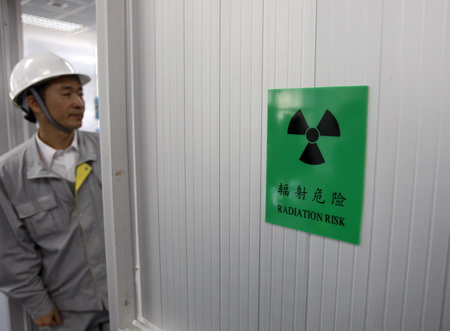
State Nuclear Power Technology Corp (SNPTC), a major nuclear power developer in China, said yesterday its first third-generation nuclear power reactor is expected to start operations in August 2013, marking the first use of the technology in the country.
Following the completion of the first reactor, located in the Sanmen nuclear power project in Zhejiang province, the company's other three reactors will start generating power by 2013 and 2014, said Wang Binghua, chairman of SNPTC.
The four reactors, which use the AP1000 technology from the US-based Westinghouse, each has capacity of 1,250 mW. SNPTC signed an agreement with the Westinghouse-led consortium for the use of the technology to build four reactors, a pair in Sanmen in Zhejiang and another two in Haiyang in Shandong.
Among the four reactors, construction of three reactors began last year.
SNPTC, which is responsible for the import and localization of the third-generation nuclear power technology, is also preparing for the construction of China's first three inland nuclear power projects in Hubei, Hunan and Jiangxi provinces.
The three projects will also use the AP1000 technology. They will meet the requirements for starting construction this year, said Wang.
"Work on our third-generation reactors is going on smoothly. It will certainly upgrade the technology of the domestic nuclear power industry," said Wang.
Construction of the third-generation reactors has boosted the development of the equipment-manufacturing sector, he said.
Besides the imports of the US technology, State-owned SNPTC has also started the localization work of the advanced technology. The company and China Huaneng Group recently inaugurated a joint venture to build and operate a demonstration project, which uses a technology called CAP1400.
The project is located in Weihai, Shandong province. The CAP1400 technology is based on the AP1000 technology.
Construction of the project is expected to start in April 2013. It is scheduled to start operations by 2017.
After the CAP1400 project, work on another CAP1700 project, which uses similar technology but with larger capacity of 1,700 mW, will also begin, according to SNPTC.
"Development of the third-generation reactors, which are much safer and with longer life spans fits well with China's efforts to build an environmentally friendly economy. Localization of the technology will greatly improve the competitiveness of China's nuclear power industry," said Tang Zide, a researcher with SNPTC.
China is building six third-generation nuclear power reactors in the country. Besides the four using the AP1000 technology, work on two rectors using the EPR technology developed by France-based Areva has started.